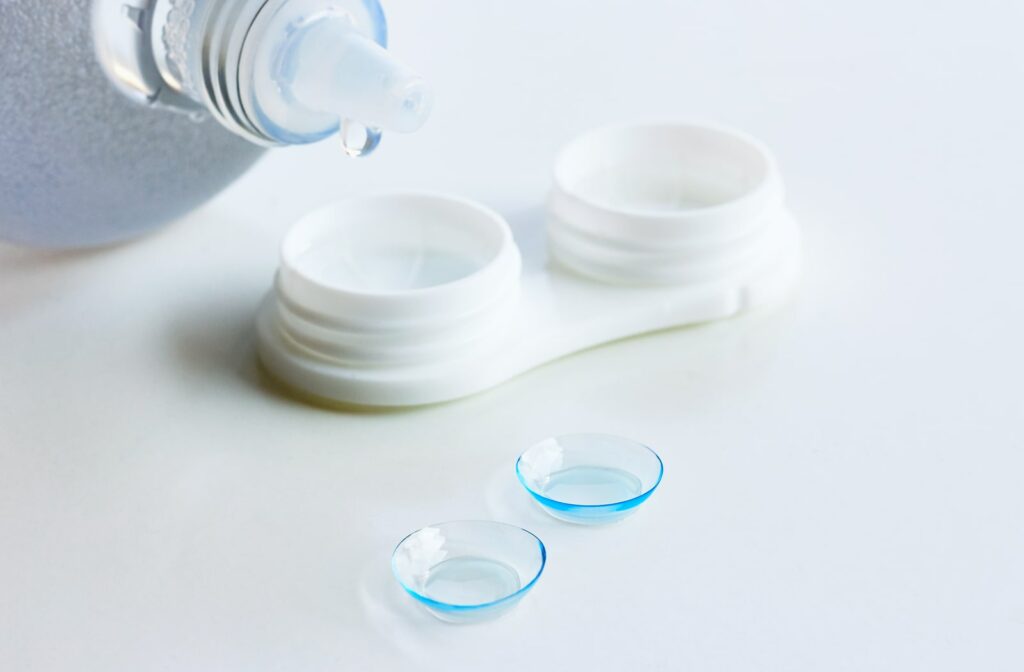Contacts aren’t all made equally. That’s why it’s important to discuss your options with an optometrist. After performing an eye exam, they offer suggestions that take things like eye shape and health into account.
When you purchase your contacts directly from the optometrist, they will typically offer a trial pair for a few days to ensure proper fitment. Once you’ve got the correct lens, you can order your full supply from them.
Your optometrist will give you all the contact lens information that is particular to you. But below, we’ve compiled a list of the options available to give you an idea of what to expect when the optometrist starts discussing the difference between contact lenses.
Different Types of Contact Lenses
Soft Contact Lenses
As the name implies, soft contact lenses are made from soft, plastic materials. The lens design enables oxygen to reach your cornea. In most cases, a soft contact lens is more comfortable than its rigid counterpart.
In some contact lens designs, the manufacturer includes a silicone-hydrogel that improves lubrication and oxygen transfer through the lens.
Extended Wear
Because of their composition, extended wear contacts last a certain amount of time with continuous wear. For example, these lenses may range from 7 to 30 days of wear.
It’s important to discuss your lens choice with the optometrist. They may recommend that you avoid extended wear lenses because of the potential agitation of underlying eye problems.
Disposable
Disposable lenses are by far the most common contact lenses on the market. Optometrists sometimes refer to them as “planned replacement” lenses.
They are often called planned replacement lenses because the manufacturer specifies the maximum life of the lens. For example, many disposable lenses are good for 30 days. Even if you’re taking them out every night and cleaning them, they still need to be replaced at the specified intervals.
It’s important to follow the manufacturer’s and your optometrist’s directions regarding contact lenses because wearing a disposable lens longer than you should will increase your chances of infection or other problems.
Daily
Another type of disposable lens is a daily lens. These are exactly as the name implies. They are designed to be worn for one day and then thrown out. There is no cleaning required, and they are better for your eye health.
Rigid Gas Permeable ( RGP) Lenses
RGP lenses are a combination of rigid plastic and silicone. Compared to a traditional hard lens, they allow much more oxygen to reach the eye. As a result, they’ve almost replaced hard lenses entirely.
If you consider their long life compared to a soft lens, RGP lenses often come out as the less expensive of the two. They are not as comfortable initially, though. So, if you have sensitive eyes, the optometrist may not recommend using them.
A major benefit to RGP lenses is their resistance to build-up, which contributes to them lasting longer than a soft lens. With proper care, these are a great contact lens to support good eye health if your eyes can get used to them.
Hard Lenses
Hard contact lenses were initially made from glass. But the use of polymethyl methacrylate (PMMA) and plexiglass made for a much more comfortable lens.
Since RGP lenses have hit the market, hard lenses are much less popular due to the lack of oxygen they allow into your eye compared to RGP or soft lenses. Also, the other options available make hard lenses much less desirable regarding comfort.
Safe Contact Use
No matter which lens you decide to use, there is always an inherent risk when regularly taking something in and out of your eye. The chances of infection or eye damage are always there.
That’s why it’s so important to practice excellent hygiene. Always wash your hands thoroughly before touching your eyes, and clean the contacts according to the manufacturer’s directions. And even if they seem okay, follow the recommended schedule for replacing the contact lenses.
Advantages and Disadvantages of Contact Lenses
While contact lenses offer us a way out of wearing glasses, they are not without disadvantages. When thinking about switching to contacts from glasses, there are several things to consider.
Advantages
- They offer a solution if you’re self-conscious about wearing glasses.
- Contacts don’t fog up with temperature changes—plus, no rain spots!
- There’s no risk of damage while playing sports or other physical activities.
- Contacts provide you with a full field of vision.
- The proper contact lens will offer you better visual acuity.
Disadvantages
- There is an inherent risk of infection or eye damage through improper handling and cleaning of contacts.
- Contact lens care requires more work compared to glasses.
- Some people simply can’t get used to a contact lens sitting on their eyes.
Closing Thoughts
If you’re ready to make the jump into wearing contacts, reach out to us today and book a contact fitting. The friendly staff at Korth Vision will go over your options with you and ensure you have the best lens for your eyes.




